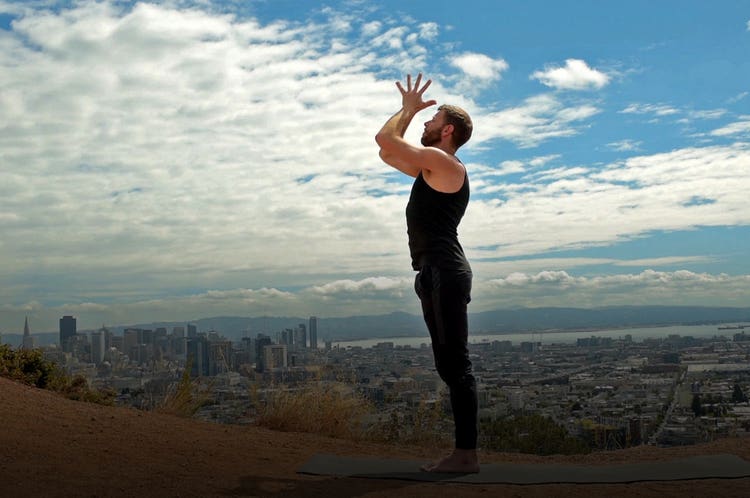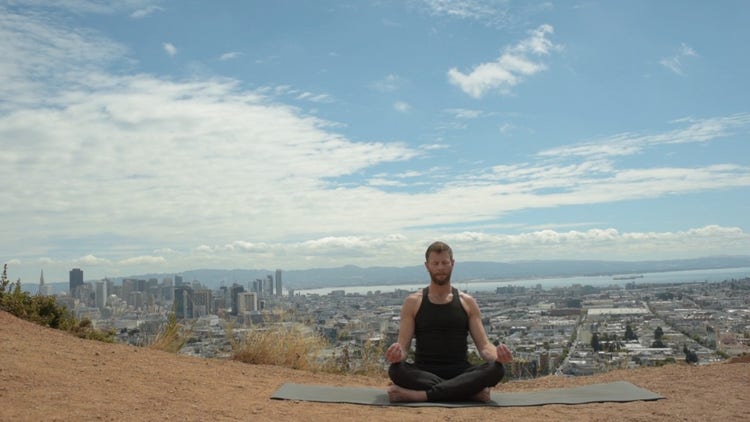Focus Your Energy

For new and seasoned yoga practitioners alike who believe the discipline is mainly a means for calming the body and mind, Greg Wieting has something energizing: a Prana Vinyasa-inspired sequence, based upon the principles of energetic alignment within “prana,” our vital life force energy.
Prana Vinyasa is characterized by its creator, Shiva Rea, as a life-realization and embodiment practice. Rea, who is in the vanguard of modern yoga practice, has developed this “embodied practice” to bring people into contact with their “sva dharma,” or inherent purpose in life, as well as greater health, wellness and even happiness and creative fulfillment. Prana vinyasa draws upon the teachings of Krishnamacharya (who drew upon the Tantric origins of vinyasa yoga) and the roots of Ayurveda and Bhakti.
Wieting explains that throughout the flow of a Prana Vinyasa-inspired sequence, we progress through pulsations and body vinyasas, or movements within poses, as well as rhythmic vinyasas. The flow, poses, movement and pulsations highlight and integrate energetic alignment and outer form. He’s chosen the following Prana Vinyasa movements and sequence for focus and energy — whether your mode of choice is yoga or some other form of movement.
(Note: If you are new to yoga, have injuries, or are still building strength in your wrists and shoulders, feel free to rest and make circles with your wrists between the poses or skip some and build up to the full sequence.)
Prana Vinyasa flow for energy and focus
1. Samana Vyana Mudra Vinyasa
In Prana Vinyasa, each flow begins with a mudra vinyasa, or movement meditation, to synchronize movement and breath and create the energetic opening to prepare for the peak pose in the practice. This movement and mudra combination brings energy into your core (“samana vayu”) so you feel centered and then helps you extend your awareness outward so you feel expansive (“vyana vayu”). Integrate these two expressions of energy.
- Stand with your feet hip-width apart, spine tall, and bring your palms to your chest.
- As you inhale, open your palms and then your arms wide, spreading your chest broadly. Root your heels to the ground as you lift your heart.
- As you exhale, coil the naval in and strengthen your core, bringing your palms in toward your heart and gathering energy into your core.
2. Downward-Facing Dog With Leg Extension and Coiled-Core Rhythmic Vinyasa
Begin in Downward Facing Dog, pressing down and forward with your hands and drawing your hips back and up.
- As you inhale, extend your right leg up to the sky, spreading the toes.
- As you exhale, bring your shoulders over your wrists and draw your right knee forward to your elbow, extending your chest and heart forward.
- As you inhale, draw your hips back as you extend your right leg behind you and then up to the sky, keeping your right thigh firmly engaged and spreading your toes.
- Exhale and bring your right knee to your right elbow again.
- Repeat three to five times and then switch legs.
3. Prana Vinyasa Four Movements of Lunge
Begin in a forward lunge, hinging forward at the hips to place your palms on the ground on either side of your front foot.
- Inhale and coil your navel as you round your back and draw your chin to your chest.
- As you exhale, radiate energy forward through your front knee and back though your extended heel.
- As you inhale, draw into your core, finding your strength.
- Exhale, opening your heart, shoulders and back.
- Inhale, rounding at the base of your spine.
- Exhale, rooting your front hip to the ground and committing your back thigh to the sky.
- Repeat three to five times and then switch legs.
4. Warrior 1: Rhythmic Vinyasa Hip-Opening Variation
From the Four Movements of Lunge, release your back foot to the earth, root the outer edge of the foot and heel, and raise the inner arch. Rooting your front hip and heel, inhale and rise into warrior 1, lifting your navel, heart and fingertips to the sky.
- As you exhale, stay broad across the chest and sweep your arms forward and down, extending your arms long at your sides. Lengthen your spine in a diagonal line. Extend your tailbone toward your back heel and firm your back and thigh to the sky.
- As you inhale, rise and lengthen through both side waists into Warrior 1.
- Exhale and flow into the diagonal, finding strength and extension with a lifted heart.
- Inhale and rise out of a strong foundation.
- Exhale and flow, drawing your front hip back, navel to spine, tailbone to back heel.
- Repeat three to five times and then switch legs.
5. Hip-Opening Core Cultivation
Integrate side waist extension, hip opening and core strength.
- Lie on your back on the floor. Engage your core as you bend your right knee, and then grasp your right ankle to gently hug your right shin to your chest. Your head, neck and shoulders will come off the ground as you hold your shin. Keep your right foot flexed to support your knee.
- Inhale, extend your left leg and press through the ball of your left foot, spreading your toes.
- As you exhale, coil your navel and draw your side ribs to the earth as you draw your left leg toward the sky.
- As you inhale, continue to press through the ball of your left foot to elongate your leg as you lower it to the ground.
- Exhale, drawing the leg to the sky and connecting to your core.
- Repeat three to five times, integrating both strength and extension, and then switch legs.
6. Chair Pose With Agni Mudra
Mudra is a symbolic hand gesture to invoke a particular quality or energy. “Agni” Mudra is a hand position and movement combination that cuts through distraction to bring focus.
- Stand tall with your feet together.
- Place your palms together in front of your heart in “Namaste” Mudra, and interlace all the fingers except the index and thumb.
- Keeping your knees and feet together, slowly “sit down” into the Chair position by bringing your hips back and bending your knees.
- Inhale and rise out of the seated position slightly, bringing the mudra up past your heart, past your brow and over the crown of your head as you reach for the sky. As you rise, lift your navel and your heart and feel your breath expand your rib cage to either side.
- As you exhale, extend your clasped hands down in front of you, cutting slowly through the air toward the earth as you sink deeply into the seated chair again.
- Inhale, rise and extend, feeling lift and lightness.
- Exhale, allowing the flow of the arms to cut through distraction as you sit deeper into the chair.
- Inhale and flow the arms through the midline and over your head.
- Exhale and dissolve whatever stands between you and your focus.
- Repeat three to five times.
7. Arm Balance With Pulse
From a standing position, draw your right knee into the chest, and as you bend your left knee to lower yourself to the Chair position, place your right ankle across it. Keep your foot flexed, and clasp your hands in Agni Mudra.
- As you inhale, rise up, and as you exhale, “sit down,” letting your tailbone drip to the ground. Pulse up and down several times with the flow of your breath.
- Keep your chest broad, radiate your heart forward and engage your glutes as you hinge forward to place your hands on the ground in front of your feet. Let your right foot hug the back of your left arm above the elbow.
- As you press down into your palms, slowly pitch forward and lift your left heel off the ground.
- As you firmly engage your inner thigh, draw your left heel up and press through the ball of the foot, spreading the toes as you extend your leg to the sky.
- Coil the navel, lengthen through your sides and then slowly release the pose.
- Repeat the sequence with your left knee and ankle crossed over your right.
- Allow the breath to be full and complete, with equal inhalation and exhalation. Only stay in the pose as long as you can maintain a fluid breath.
8. Seated Samana Vyana Mudra Vinyasa
Transition from the Arm Balance pose to a seated position. In this final seated mudra vinyasa, you’ll connect to both your innermost core and the expanse of your outer awareness. A central point of focus from your center can radiate out omnidirectionally like rays of the sun. Sit on a mat or on the floor or ground with your legs crossed. Soften your jaw. Feel your sitting bones rooted to the ground, and place your palms over your heart.
- As you inhale, open your palms and let your arms radiate outward.
- As you exhale, bring your hands back to your heart and a central point of focus.
- Inhale vyana vayu, allowing your awareness to move outward.
- Exhale samana vayu and draw your awareness back inside.
- Continue for several cycles of breath. While you expand out, stay connected to your core. As you coil in, maintain an expansive outer awareness.
9. Samana Vayu Mudra Meditation

Samana Vayu Mudra helps you bring your practice and your awareness to a central point of focus. It helps you assimilate and digest life experiences so you can be present to what is, and it helps you come back to your center so you can cultivate a relaxed yet alert awareness.
- When you feel ready, bring the fingertips and thumb of each hand together. Allow your wrists to rest on your knees or thighs.
- As you feel your sitting bones rooted to the ground, feel the suspension and lift within your heart. Release your jaw, shoulders and belly.
- Allow your breath to be natural. Whenever there is a choice, bring your awareness back to your breath and feel the tips of your fingers pressing to your thumbs.
10. Closing
Breathing evenly, place your palms together and press your thumbs to your sternum. As you exhale, bow your head to your heart. Inhaling, draw your thumbs up over your brow and lift your head. Namaste.
Full flow
Please see the video below for the full Prana Vinyasa-inspired sequence. Be sure to move within the context of your breath. Equal inhales, equal exhales. Allow the breath to be full and complete. This way you are sure to stay open and receptive without creating more tension or over gripping or causing harm. If you ever lose contact with your breath, be sure to back out of the pose and don’t go so deep. Always listen to your body first to support and honor your body and your practice.